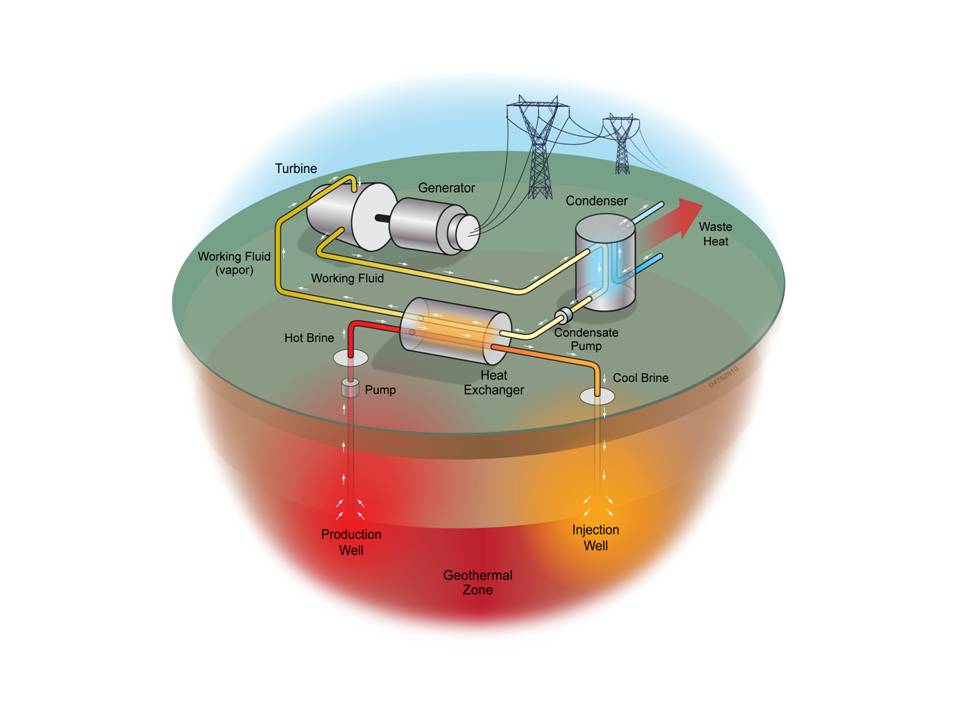
Geothermal
Geothermal Energy Resources
Miles below the crust, the earth has a molten core, heated by gravitational forces and other mechanisms. Geothermal energy is the thermal energy in the earth’s core. Geothermal energy resources include conventional hydrothermal resources, geopressured geothermal systems, enhanced geothermal systems (EGSs), and low temperature co-produced geothermal resources. In some locations in the world where hot springs or geysers exist, the hydrothermal energy has been employed to generate electricity. Also, in rare locations, molten magma, or lava, is close to the surface and can be tapped for thermal energy to generate steam. Nearly 10,000 MW of electric capacity from hydrothermal sources is used worldwide, with more than 3,000 MW of that being used in the United States. However, no significant hydrothermal resources have been identified within the Eastern Interconnection.
Geopressured resources (those under pressure in the earth) are found in highly pressurized1 shale and sandstone formations that contain high-temperature brine with dissolved methane. Their energy potential includes both thermal energy and the methane stored in reservoirs. The thermal energy can be used in a steam-driven electric generator, and the methane can be used as fuel. The best geopressured reservoirs are generally found along the Texas and Louisiana Gulf Coast.
EGSs are resources that contain a large amount of thermal energy but lack sufficient in situ water, permeability, or both, so that the reservoir must be engineered to extract the thermal energy. EGS resources are divided into (1) near-hydrothermal-field EGS resources, which are located near conventional hydrothermal fields, and (2) deep EGS resources, which, in theory, can be developed anywhere by drilling deeply enough to access high-temperature reservoirs.
Low temperature co-produced geothermal resources can be accessed as a part of oil and gas production activities. During oil and gas production, large quantities of water can be co-produced with the oil and gas. Some of this co-produced water is at a high enough temperature that it can be used to generate electricity. It is estimated that active oil and gas wells in the United States are capable of producing 300 MW of geothermal power with the majority of this power potential located in Texas outside of the Eastern Interconnection.
Geothermal Energy Technology
Conventional hydrothermal resources typically use one of three types of power plants, depending mostly on the temperature of the geothermal resource. A direct steam power plant is used when the geothermal reservoir produces steam. The steam is used to directly drive a turbine. A flash steam power plant is used when the geothermal reservoir produces water at temperatures higher than about 360°F (182°C). This hot water flows under its own pressure from the wells. As it flows upward, the pressure decreases, and some of the hot water can boil into steam. More steam is produced in the plant by reducing the pressure of the produced fluid in a flash vessel. The steam is then separated from the water and used to power a turbine/generator. A binary power plant is used when the reservoir is not hot enough to produce enough steam to justify the use of a flash plant. Instead, the hot water is passed through a heat exchanger to vaporize a secondary fluid, such as pentane, that is then used to power a turbine. The secondary fluid is then condensed and pumped back to the heat exchanger in a closed loop. In all of these plants, the geothermal fluidsare typically injected back into the reservoir, making this a renewable resource.
The traditional geothermal approach relies on finding naturally occurring pockets of steam and hot water. The EGS process, by comparison, replicates these conditions by fracturing hot rock, circulating water through the system, and using the resulting steam to produce electricity in a conventional turbine. The water is then re-injected back into the rock, where the cycle begins again in a closed loop. Under ideal conditions, the water might be used directly in a steam power cycle or in a binary cycle.
Most EGS resources will use the binary cycle power plant design. (Figure 1). Binary cycle plants use the hot water resource to boil a working fluid, usually an organic compound with an appropriate lower boiling point. The water and the working fluid are kept separated during the whole process. The working fluid is vaporized in a heat exchanger and used to turn a turbine. The water is then injected back into the ground to be reheated.

Because EGSs are still primarily in the demonstration stage, the estimates of the potential of this resource are subject to considerable uncertainty. The vast majority of the geothermal potential for EGS within the contiguous United States can be found in the western portion of the country. However, even the Eastern Interconnection has enormous potential for EGS development.
References
Augustine, C., R. Bain, J. Chapman, P. Denholm, E. Drury, D.G. Hall, E. Lantz, R. Margolis, R. Thresher, D. Sandor, N.A. Bishop, S.R. Brown, G.F. Cada, and F. Felker, 2012. Renewable Electricity Futures Study. Renewable Electricity Generation and Storage Technologies, TP 6A20-52409-2, Vol. 2, National Renewable Energy Laboratory, Golden, CO.
Augustine, C. and D. Falkenstern, 2012, An Estimate of the Near-Term Electricity Generation Potential of Co-Produced Water From Active Oil and Gas Wells, GRC Transactions, 36: 187-200.
GEA (Geothermal Energy Association). (n.d.). “Geothermal Power Plants – USA.” http://www.geo-energy.org/plants.aspx. “2.4 How Much Energy Does Geothermal Supply Worldwide?” http://www.geo-energy.org/currentUse.aspx#world.
Lopez, A., B. Roberts, D. Heimiller, N. Blair, and G. Porro, 2012, U.S. Renewable Energy Technical Potentials: A GIS-Based Analysis. NREL/TP-6A20-51946. National Renewable Energy Laboratory. July. http://www.nrel.gov/analysis/re_futures/.
MIT (Massachusetts Institute of Technology), 2006, The Future of Geothermal Energy: Impact of Enhanced Geothermal Systems (EGS) on the United States in the 21st Century. INL/EXT-06-11746. Work performed by Massachusetts Institute of Technology, Cambridge, Massachusetts, for Idaho National Laboratory and U.S. Department of Energy. http://www1.eere.energy.gov/geothermal/pdfs/future_geo_energy.pdf.

